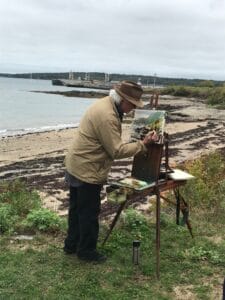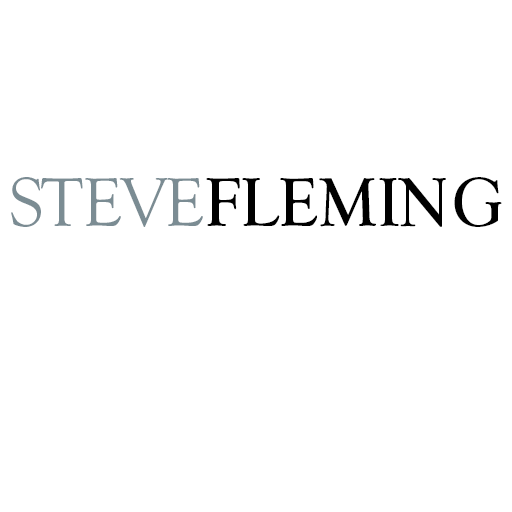About Steve
 Good art is the result of hard work and dedication. It only happens when the artist finds his or her own story to tell and then learns to do so with his or her own unique language.
Good art is the result of hard work and dedication. It only happens when the artist finds his or her own story to tell and then learns to do so with his or her own unique language.
I am finally at the point in my art career where creativity and expressiveness are more important to me than my ability to represent things correctly. What I am working on must come from my desire to say something or to react to something and not just be something. My concern is to let my inner creative voice come out on the paper and to not be concerned whether what I am doing is following the pack of accepted traditional painters. I want to tell a story, express a mood or reaction, or expand the boundaries of my creative efforts. Today I paint, teach, and study art, and all of these efforts make my work more expansive and personally expressive. I began my painting with Skip Lawrence in his Laurel, Md. studio in the mid-1970s and I am fortunate that he was my first and really only teacher. He stressed creativity, color, design, shape-making, and the need for the artist to be an individual and to tell their own story. He also introduced me to the world of great artists and wonderful watercolor painters. Although at the time I really had no recognizable talent as a painter he lit a fire in me and for that, I am eternally grateful to him.
 Now, some thirty years later, I too absolutely believe in and promote the ideas that were instilled in me during my three years with Skip. I have studied and continue to study the work and lives of great artists learning about their lives, philosophies, aspirations, and failures. I have included on this blog a list of books I have read or am reading for you to look into. It is always a wonderful revelation to see where some of these painters started and to follow their transformation from beginner artist to creative master. This intimate understanding of the artists gives me the confidence to try more expressive things in my own art and to not concern myself with the attitudes and criticisms of fellow artists who are afraid of new directions in painting. I believe that by using everything I know and by reaching outside my comfort level I have the possibility of painting a great painting. I know this hasn’t happened yet and won’t happen even if I am afraid to make a personal statement in my art. Art is not just about safety, sales, number of students, and awards won, it is about creative expression and personal vision combined with the trained eye and hand. I am still in the process of becoming an artist and I am continuously fighting to lose my fear of putting myself in the painting and my fear of the rejection of my ideas. I am striving to paint my own art and I am struggling with finding and using my own creative voice
Now, some thirty years later, I too absolutely believe in and promote the ideas that were instilled in me during my three years with Skip. I have studied and continue to study the work and lives of great artists learning about their lives, philosophies, aspirations, and failures. I have included on this blog a list of books I have read or am reading for you to look into. It is always a wonderful revelation to see where some of these painters started and to follow their transformation from beginner artist to creative master. This intimate understanding of the artists gives me the confidence to try more expressive things in my own art and to not concern myself with the attitudes and criticisms of fellow artists who are afraid of new directions in painting. I believe that by using everything I know and by reaching outside my comfort level I have the possibility of painting a great painting. I know this hasn’t happened yet and won’t happen even if I am afraid to make a personal statement in my art. Art is not just about safety, sales, number of students, and awards won, it is about creative expression and personal vision combined with the trained eye and hand. I am still in the process of becoming an artist and I am continuously fighting to lose my fear of putting myself in the painting and my fear of the rejection of my ideas. I am striving to paint my own art and I am struggling with finding and using my own creative voice
Welcome to my blog! Visit often. Stir things up in the comments. Learn. Buy a painting. Enjoy.


Google lead me to your blog and web site via your Value Pattern tutorial on artinstructionblog.com I’m impressed! It was the most insightful article on value studies I have read. Add the ‘why’ to the ‘how’ makes all the difference IMOSHO.
If you have the time and the subject appeals to you, consider writing about how you choose the size and format for a painting, e.g.Ian Robert’s “The Four Most Important Compositional Lines”
all the best
Steve,
I follow your painting progress closely. You make very strong paintings. The images linger in my mind.
Jo Ann Goldberg
Hi Steve, I found you on youtube while doing a search for “opaque watercolor.” I’ve watched your vids over and over. I’m committed to learning as much as I can, and saying as much as I can say, with gouache. Wish you would do more vids!!! I just now found your About Me page and I am deeply inspired with all that you say.
I am blessed to be attending my first Skip Lawrence workshop in a couple of weeks….nervous, excited…exhilarated for what I believe will be a significant Breakthru.
Blessings to you and Paint ON!
Joanie
I follow your painting progress closely. I really like what you do, how you do it and how you tell about it. I wanted to know more about you, where are you from, and how you came to be a great artist. I found this blog that I read completely. How interesting is all you write here!. I’m also struggling with finding and using my own creative voice, but I don’t know how to start to it.
Estoy de acuerdo con usted. Me encuentro en la tesitura de evolucionar hacia un impresionismo que me ayude a buscar mi individualidad y sus vídeos y sus consejos me van ayudando a comprender algunas cosas.
Please add me to your email list of exhibits, etc. Your work is very beautiful.
I really love those paintings!! Can’t wait for Maine !!
Your site is teaching me a lot…..love your abstracts!
I will try to put up some more thanks for checking out the site
Hi Steve,
I found your 1999 ad for workshops in The Artist’s Magazine.
The web address was not workable for me
Do you still do East Coast workshops. I am in NJ and travel to the Arlington area to visit my sister. Please share any updates about future 2016 activities. The Blue Ridge and Shenandoah are of particular interest to me.
I am a watercolorist and do some Pastel.
Thanks for your consideration.
Zina
Rosina, I will keep you posted but at the moment the only workshop I have scheduled is my 1 and 2 week workshop in Maine, September 2016
Hi Steve, love your paintings! Please do some more videos on you tube. Thanks
Again,I did learn from the class yesterday and have had several ideas moving about my brain during class that have stayed with me through today.
I went over your list of “make sure” items today in relationship to my painting of the Roussillon cliffs in particular the comments about the “center of interest with an area of high contrast”. I don’t know quite how to that questions with this painting.
At the end of the day your mentioned making the cliffs even larger which was my original inclination but felt that it would become too dominant so I sized it back to allow me to play with the shapes and the negative space. I do however get the point of making it bigger. I have always followed the idea that if you are going to make something bold, go for it. If you are doing something quiet and subtle, go for it;no in between land.
I think of the cliffs as “meditative contemplation” and think of the great work of Mark Rothko who did not really have a center of interest per se except where the dominant colors come together or the interplay between his floating rectangles and the space around and behind them. His paintings become highly complicated as you absorb them. His late paintings in the Rothko Chapel in Houston are divided into two sections with dark green on the bottom and brown top (a minimalist landscape?)BUT they are complicated.
I get the idea of minimizing the contrast or high value changes when you deal with such a dominant color and shape as I was to really push the concept.
Thoughts/clarifications that might be helpful?
David Haas
David If you read about Rothko you will note that he felt the painting was the subject. He wanted the viewer to sit 4.8 feet back from the painting so they would feel immersed in the work. It is very difficult to get the same effect with a small piece. I think if you stay true to the idea of the orange being the center of interest and keep it very minimal you will be happy. Paint it bigger.